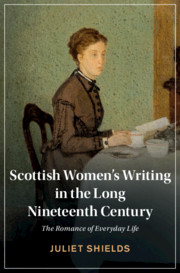Book contents
- Scottish Women’s Writing in the Long Nineteenth Century
- Cambridge Studies in Nineteenth‐Century Literature And Culture
- Scottish Women’s Writing in the Long Nineteenth Century
- Copyright page
- Contents
- Acknowledgments
- Introduction
- Chapter 1 Oliphant, Scott, and the Novelist’s Trade
- Chapter 2 Annie S. Swan’s Friendly Fiction
- Chapter 3 The Scottish New Woman and the Art of Self-Sacrifice
- Chapter 4 The Colonial Adventure Story and the Return of Romance
- Chapter 5 Scottish Modernism and Middlebrow Aesthetics
- Conclusion
- Bibliography
- Index
- Cambridge Studies in Nineteenth-Century Literature and Culture
Chapter 4 - The Colonial Adventure Story and the Return of Romance
Published online by Cambridge University Press: 27 July 2021
- Scottish Women’s Writing in the Long Nineteenth Century
- Cambridge Studies in Nineteenth‐Century Literature And Culture
- Scottish Women’s Writing in the Long Nineteenth Century
- Copyright page
- Contents
- Acknowledgments
- Introduction
- Chapter 1 Oliphant, Scott, and the Novelist’s Trade
- Chapter 2 Annie S. Swan’s Friendly Fiction
- Chapter 3 The Scottish New Woman and the Art of Self-Sacrifice
- Chapter 4 The Colonial Adventure Story and the Return of Romance
- Chapter 5 Scottish Modernism and Middlebrow Aesthetics
- Conclusion
- Bibliography
- Index
- Cambridge Studies in Nineteenth-Century Literature and Culture
Summary
CH 4: Flora Annie Steel and Violet Jacob participated in the late nineteenth-century romance revival that harkened back to the adventure stories pioneered by Walter Scott. The imperial romance’s focus on cultural conflict and conquest and its exotic settings were the antithesis of the everyday life that Steel’s and Jacob’s countrywomen tended to depict. However, Steel and Jacob did not simply imitate or borrow wholesale the generic conventions developed by Scott and Robert Louis Stevenson but instead challenged the imperial romance’s cult of manliness. Steel drew on the conventions of the New Woman novel to foreground women’s participation in the adventures of empire-building. She critiqued the masculine exclusivity of adventure fiction, but not the imperial ideologies it propagated. Jacob’s novels take male adventurers as their protagonists but turn the imperial romance’s focus on conflict and conquest inward in two senses, from Britain’s overseas empire to its Celtic peripheries, and from physical to psychological struggle. Set in Wales and Scotland, Jacob’s novels explore the borderlands where English policies and practices meet indigenous traditions, and where divided cultural allegiances lead to moral conflict.
- Type
- Chapter
- Information
- Scottish Women's Writing in the Long Nineteenth CenturyThe Romance of Everyday Life, pp. 120 - 149Publisher: Cambridge University PressPrint publication year: 2021



